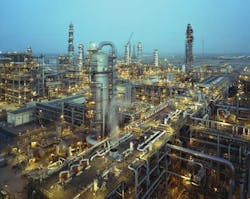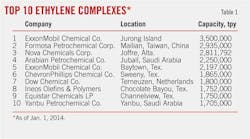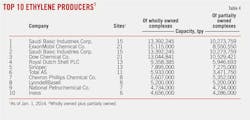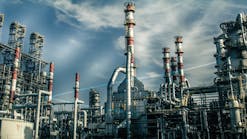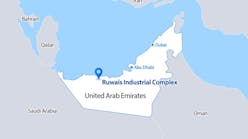Rising demand, low-cost feed spur ethylene capacity growth
Robert Brelsford
Downstream Technology Editor
| OGJ subscribers can download, free of charge, the 2014 Worldwide Ethylene Survey tables at www.ogjonline.com: Scroll to "Surveys and Statistics." Click on OGJ Subscriber Surveys, then Ethylene Report, and choose from the list below July 7, 2014. To purchase spreadsheets of the survey data, please go to http://www.ogj.com/resourcecenter/orc_survey.cfm or email [email protected]. |
Global ethylene production capacity in 2013 rose at faster rates compared with 2012 and 2011 but still more slowly than record-setting capacity expansions achieved during 2010, according to Oil & Gas Journal's latest survey of the industry.
As of Jan. 1, 2014, producers had increased global capacities by 2.6 million tonnes/year (tpy) from a year earlier to more than 146 million tpy.
Global capacities of 143.4 million tpy as of Jan. 1, 2013, had grown by about 2.5 million tpy from 2012, which was nearly as much as capacities increased by the same period in 2011 (OGJ, July 1, 2013, p. 90; July 2, 2012, p. 78).
At the end of 2010, global capacities had set a record (OGJ, July 4, 2011, p. 100), exceeding capacity added in 2009 (OGJ, July 26, 2010, p. 34) and in 2008 (OGJ, July 27, 2009, p. 49).
Regional view
Table 1 shows rankings of the 10 largest ethylene production complexes in the world. The order for 2013 changed from 2012, with the entry of one complex leading to the removal of another, OGJ survey data showed.
ExxonMobil Chemical Co.'s Jurong Island complex in Singapore entered the list to displace Nova Chemical Corp.'s Joffre, Alta., complex as the world's largest, pushing Equate Petrochemical Co.'s Shuaiba, Kuwait, complex into eleventh place.
Table 2 ranks ethylene production capacity by region; Table 3 shows changes for individual countries between 2013 and 2014.
Table 4 lists the top 10 owners of ethylene capacity worldwide. The first column of capacities presents them for assets owned entirely by one company; the second column reflects the total of actual percentages for companies in joint ownership.
The exclusive, plant-by-plant table, based on OGJ's survey, follows this article.
The survey
While OGJ's survey of the industry for 2012 showed China, the US, and the UAE adding nearly 2.8 million tpy and Japan shuttering 330,000 tpy (OGJ, July 2, 2013, p. 90), Singapore and Germany were the only countries to report capacity additions for 2013, with no closures reported in any region.
OGJ data show only one new world-scale ethylene plant starting up last year; for 2012, three started up, while two started up in 2011. In 2010, eight new plants started up with combined production capacity of 8.65 million tpy.
In December 2012, ExxonMobil began operations on one of the world's largest ethylene steam crackers at its chemical complex in Jurong Island with the multibillion dollar expansion fully commissioned by early 2014 (OGJ, July 1, 2013, p. 92; OGJ Online, Jan. 8, 2014).
The expansion project added 2.6 million tpy of finished product capacity at Singapore to make it the largest chemical expansion in ExxonMobil's history. The expansion, said ExxonMobil, positions the complex to meet rapidly growing global chemical demand, two thirds of which will come from Asia-Pacific (OGJ Online, Jan. 8, 2014).
As of Jan. 1, 2014, ethylene production capacity at the Jurong Island complex rose to 3.5 million tpy from 900,000 tpy for the same period in 2013, according to OGJ survey data.
In addition to one of the world's largest ethylene steam crackers, the Singapore expansion includes two polyethylene plants, a polypropylene plant, a metallocene elastomers unit, an oxo-alcohol unit, and an aromatics expansion (OGJ Online, May 30, 2013; Dec. 28, 2012), as well as a steam cracker capable of processing a wide range of feedstock—from light gases to crude oil—to produce an expanded slate of premium and commodity petrochemicals (OGJ Online, Jan. 8, 2014).
The Singapore chemical complex, which now accounts for about one quarter of ExxonMobil's global chemical capacity, came on stream in 2001 and is integrated with the company's 605,000-b/d Singapore refinery (OGJ Online, Jan. 8, 2014; July 3, 2001).
This year's survey also showed a boost of more than 14,000 tpy to capacity at one of two steam crackers at the BP PLC-operated Ruhr Oel GMBH Gelsenkirchen refinery and integrated petrochemical production complex in Germany. The capacity increase resulted from updated operational data reported by BP, which jointly owns the complex with Russia's OAO Rosneft (OGJ Online, May 6, 2011).
Construction
If all projects under construction remain on announced schedules, 2014 will see capacity increase by nearly 4 million tpy. While currently that pace is set to halve in 2015 to a bit more than 2 million tpy, as evinced by the surge of announcements for new cracker investments over the past year, much will depend on producers' access to low-cost feedstocks, particularly in North America.
With North American operators such as Enterprise Products Partners LP (EPP) poised to increase ethane exports as US ethane production exceeds regional demand (OGJ Online, Apr. 22, 2014), beyond 2016, the global construction pace for ethylene and related capacity could begin to accelerate again as producers capture attractive pricing for feedstock.
Asia-Pacific
In November 2012, China Petroleum & Chemical Corp. (Sinopec) said it would increase crude refining capacity at its Yangzi Petrochemical unit by 250,000 b/d by mid-2014 and wanted to expand its ethylene capacity by adding an 800,000-tpy unit (OGJ, July 1, 2013; p. 90).
While Sinopec issued no official timetable with the announcement, by August 2013 subsidiary Sinopec Wuhan Co. had confirmed that the 800,000-tpy ethylene project had produced its first batch of "qualified products," marking the plant's successful commissioning and start-up (OGJ Online, Aug. 21, 2013).
The project is a joint venture between South Korea's SK Corp. (35%) and Sinopec (65%). Built in 3 years with a total investment of $2.7 billion, it includes 11 greenfield major production units with public utilities and supporting facilities and will produce 2.3 million tpy of more than 20 kinds of products.
In December 2013, CNOOC Oil & Petrochemicals Co. Ltd., a wholly owned subsidiary of China National Offshore Oil Corp. (CNOOC), awarded Technip, Paris, a contract to supply its technology and process design package for a grassroots 1-million-tpy ethylene plant in Huizhou, Guangdong Province (OGJ Online, Dec. 20, 2013). Production from the ethylene plant will feed other downstream units at the complex, including a 300,000-tpy grassroots cumene plant.
The ethylene plant comes as part of Phase 2 of CNOOC's Huizhou refinery integration project, which was approved in May 2013 by China's National Development and Reform Commission. Currently under way, the project is scheduled for mechanical completion by mid-2015.
Following a 330,000-tpy reduction to ethylene production capacity in 2012, Japan maintained capacities in 2013, with some producers in early 2014 announcing plans to consolidate operations instead of closing entirely.
In March 2014, Asahi Kasei Corp. and Mitsubishi Chemical Corp. agreed to unite their naphtha cracking operations in Mizushima, Japan (OGJ Online, Mar. 7, 2014).
Asahi Kasei will shutter the 500,000-tpy naphtha cracker at its Mizushima plant and share in the operation of the existing 500,000-tpy cracker at Mitsubishi's nearby complex. The unification of operations is scheduled for April 2016 following a planned upgrade to the naphtha cracker at Mitsubishi's plant, which will boost its ethylene capacity to 570,000 tpy.
The companies, which together previously established Nishi Nippon Ethylene LLP in April 2011 to unify management of their respective Mizushima naphtha crackers, made the decision jointly to operate a single cracker in order to optimize production configuration and efficiency as well as strengthen competitiveness in the Mizushima industrial zone.
But plans remain under way for previously announced capacity closures in Japan (OGJ, July 1, 2013, p. 90).
This year, Mitsubishi will close its No. 1 ethylene unit with a capacity of 390,000 tpy at its Kashima complex in eastern Japan to reduce fixed costs there by $50 million/year just after boosting capacity of the plant's No. 2 unit by 50,000 tpy to 540,000 tpy.
Sumitomo Chemical last year announced plans to close an ethylene plant at its petrochemical plant at Chiba, with that shuttering to take place on or before September 2015.
In India, Reliance Industries Ltd. (RIL) has advanced plans for a refinery off-gas cracker (ROGC) plant as part expanding its Jamnagar refining and petrochemical complex in Gujarat on the western coast following the award of an engineering and procurement services contract to Technip (OGJ Online, July 1, 2013).
The ROGC plant will be among the largest ethylene crackers in the world, with products from that plant to be used as feedstock for the new downstream petrochemical plants.
In April 2014, RIL secured loans from a consortium of Japanese banks totaling about $550 million to help fund the Jamnagar ethylene capacity expansion, according to a press release from the Japan Bank for International Cooperation, one of the lenders.
Also late last year in Indonesia, state-owned PT Pertamina began the process that will lead to construction and operation of a naphtha cracker (OGJ, July 1, 2013, p. 90). The project is part of a plan to increase its share of the Indonesian petrochemical market (OGJ Online, Dec. 18, 2012).
The cracker will start up at an unspecified site in Java or Sumatra by 2018 to produce 250,000 tpy of ethylene, 400,000 tpy of polyethylene, 350,000 tpy of polypropylene, and 200,000 tpy of polyvinyl chloride (PVC).
Pertamina and partner PTT Global Chemical Public Co. Ltd. were to have completed a feasibility study of the $5 billion project by late second-quarter 2014, Pertamina said in a series of December 2013 releases.
Also in Indonesia, PT Chandra Asri Petrochemical (CAP) obtained funding to complete a planned naphtha cracker expansion to increase ethylene production at its plant in Ciwandan, Cilegon, in Banten Province (OGJ Online, Dec. 10, 2013). CAP signed the 7-year term loan facility agreement, which amounts to $265 million, with various local and international banks, including Bangkok Bank PCL, Siam Commercial Bank PCL, Indonesia Eximbank, DBS Bank Ltd., and Deutsche Bank AG.
The loan will be used to finance capital expenditures in connection with expansion of CAP's Lummus naphtha cracker capacity to 860,000 kilotons/year (kt/y) from a previous 600,000 kt/y. The cracker expansion project, estimated to cost $380 million, began in fourth-quarter 2013, with commercial production slated to start at yearend 2015.
Elsewhere in the region, beyond start-up of ExxonMobil's Jurong Island expansion, Singapore remains an active spot for increased ethylene capacity in Asia-Pacific.
Royal Dutch Shell PLC still plans to expand its ethylene cracker at its Shell Eastern Petrochemicals Complex on Jurong Island. The expansion will follow a debottlenecking of the cracker to 1 million tpy of ethylene, propylene, and benzene from then-current 800,000 tpy (OGJ, July 1, 2013, p. 90).
Korea Petrochemical Industry Co. also remained on schedule to complete an ethylene oxide and ethylene glycol plant in its Ulsan petrochemical complex in South Korea in May 2014.
Middle East
Qatar Petroleum and Qatar Petrochemical Co. Ltd. (Qapco) awarded contracts to build the Al Sejeel petrochemical complex at Ras Laffan, which will include an ethylene cracker fed by natural gas produced from Qatari projects and will produce ethylene, high-density polyethylene (HDPE), linear low-density polyethylene (LDPE), polypropylene, and butadiene. Start-up targets 2018.
With the award of the front-end engineering and design (FEED) contract alongside technology selection agreements and the project management contract awarded earlier in second-half 2013 (OGJ Online, Dec. 16, 2013; July 10, 2013), the Al Sejeel project is now entering its fourth phase of nearing completion, Qapco said in December 2013.
Oman Oil Refineries & Petroleum Industries Co. (ORPIC) in March 2014 let a contract to CB&I to provide ethylene technology and FEED services for its proposed Liwa Plastics Project (LPP) at the Sohar Industrial Port Area in Oman (OGJ Online, Mar. 31, 2014).
CB&I will deliver FEED services for a grassroots 800,000-tpy ethylene plant, a pygas unit, a methyl tertiary butyl ether and butene-1 unit, two polymer plants, a gas plant and pipeline, as well as related off sites and utilities. The planned ethylene plant will use technology provided by CB&I, including its SRT cracking heaters and its recovery section design, which features low-pressure separation and mixed refrigeration to minimize investment costs.
LPP, which is based on a steam cracker and will enable ORPIC to produce polypropylene as well as polyethylene, will be adjacent to the company's existing refinery and petrochemical plants at Sohar. Valued at $3.6 billion, the project is scheduled to be completed in 2018.
In Saudi Arabia, Rabigh Refining and Petrochemical Co., a joint venture of Saudi Aramco and Sumitomo Chemical Co., continues work to expand ethylene capacity at its refinery and chemicals complex on the Red Sea (OGJ Online, Oct. 22, 2012; Mar. 23, 2009).
The Phase 2 expansion is progressing, the company said in the 2013 annual report to its board of directors. The expanded plant will be able to produce 300,000 tpy of ethylene and is to be completed in 2015.
In May 2014, state-owned TurkmenGaz let an $800 million contract to a consortium of engineering firms led by Toyo Engineering Corp. for construction of a gas chemical complex in the Turkmenbashi district of Balkan Province in western Turkmenistan (OGJ Online, May 12, 2014). The complex—which will use natural gas from the Caspian Sea to produce 400,000 tpy of ethylene, HDPE, and 80,000 tpy of polypropylene—is scheduled to be completed in 2018, Toyo said. Turkmengaz plans to export and sell polymer products manufactured at the complex mainly to markets in Asia Pacific, the EU, and Turkey.
Africa
Carbon Holdings Ltd. (CHL) of Egypt continued to let contracts for work related to the Tahrir petrochemical complex planned at Ain Sokhna, Egypt (OGJ Online, Oct. 19, 2010). Drake & Scull International PJSC (DSI) will execute engineering, procurement, construction, and commissioning (EPCC) related to utilities and off site installations for the complex (OGJ Online, May 16, 2014), while previous EPCC contracts were let to a consortium of Maire Tecnimont SPA, Milan, and Netherlands-based Archirodon Group NV (OGJ Online, Apr. 7, 2014).
Once completed, the Tahrir complex—which will be at the entry of the Suez Channel—will have a combined ethylene and polyethylene production capacity of about 1.4 million tpy, making it the world's largest naphtha liquid cracker as well as Egypt's first.
The naphtha cracker also will have a capacity to produce 900,000 tpy of propylene, 250,000 tpy of butadiene, 350,000 tpy of benzene, and 100,000 tpy of hexane-1.
The Tahrir project continues its wait to secure more than $3.4 billion in funding and loan guarantees from the US Export-Import Bank, Export-Import Bank of Korea, Korea Insurance Corp., and Italian export credit agency SACE. In the meantime, Carbon Holdings plans to begin construction on the project in 2015, according to DSI. Total investment required for the Tahrir petrochemical complex will amount to more than $5 billion.
In South Africa, Sasol Ltd. commissioned a 47,000-tpy ethylene purification unit at its polymers plant in Sasolburg (OGJ Online, Jan. 14, 2014). Already in operation, the $175 million ethylene purification Unit 5 (EPU5) is designed to address growing local demand for polyethylene material as well as boost utilization of Sasol's existing downstream polyethylene operations.
Sasol expects EPU5 to reach half its 47,000-tpy capacity within 6 months, with the plant slated to reach full capacity by 2017. The expansion at Sasolburg also was designed to reduce hydrocarbon flaring, which will reduce the carbon footprint of the company's total ethylene production operations in South Africa.
Russia, Europe
In September 2013, a unit of OAO Lukoil resumed operations at a petrochemical plant in Kalush, Ukraine, after suspending production in September 2012 "due to unfavorable conditions in the petrochemical market," the company said (OGJ Online, Sept. 17, 2013).
Karpatneftekhim has the capacity to produce 300,000 tpy of polyvinyl chloride, 200,000 tpy of caustic soda, 180,000 tpy of chlorine, 250,000 tpy of ethylene, and 100,000 tpy of polyethylene.
Open Joint Stock Co. (OJSC) Kazanorgsintez let a services contract to Technip for a grassroots furnace for cracking high- capacity, low-cost ethane and propane at its ethylene plant in Kazan, Tatarstan, Russia (OGJ Online, Feb. 17, 2014).
The project comes as part of OJSC Kazanorgsintez's cracking furnaces replacement program and follows an SMK double-cell cracking furnace Technip supplied to the ethylene plant in 2007.
But ethylene and propylene production capacity at Lukoil's 350,000-tpy Stavrolen petrochemical complex in Budennovsk, Russia, following a Feb. 26, 2014, fire will remain shuttered until January 2015 (OGJ Online, Jun. 4, 2014; Feb. 27, 2014).
In 2012, Lukoil announced project plans for the Stavrolen industrial site designed to equip the complex to process gas produced in the northern Caspian. Commissioning of the first stage of a 2-billion-cu m/year gas processing plant and modernization of existing ethylene and polyethylene units at the complex previously were scheduled for 2015 (OGJ Online, Sept. 25, 2012).
Late in 2013, Ineos Europe AG, Switzerland, confirmed the opening of its 1-million-tpy, deep-sea ethylene terminal at its Zwigndrecht plant near Antwerp, Belgium, designed to balance shortfalls in the company's large demand by allowing it to import ethylene (OGJ Online, Nov. 8, 2013).
By early 2014, Ineos had signed a new purchase agreement with Consol Energy Inc., Pittsburgh, for US ethane to be exported to Ineos's European cracking operations in Grangemouth, UK; Koln, Germany; Lavera, France; and Rafnes, Norway (OGJ Online, Feb. 17, 2014). Ethane will be transported through the Sunoco Logistics LP-operated Mariner East pipeline and terminal and imported by sea for use in Ineos's European cracker complexes, with supplies scheduled to start from 2015.
Ineos had signed a previous deal to ship ethane out of the Marcellus area in western Pennsylvania to its European crackers through the Mariner East pipeline in 2012 (OGJ Online, Oct. 8, 2012).
Ineos also let a contract for construction of an ethane terminal in Grangemouth, part of its $500 million survival plan to import US shale gas to its 210,000-b/d refinery and petrochemical complex (OGJ Online, Mar. 28, 2014).
The company said the ethane terminal will enable Grangemouth to remain competitive as Ineos looks to replace quickly dwindling North Sea feedstocks.
As part of the survival plan, Ineos said it also was moving ahead immediately with the closure of its old ethylene cracker (G4) and the associated butadiene (BE3) plant at Grangemouth.
Shuttering of the G4 and BE3 plants, which were built in the 1960s, will allow the company to concentrate on increasing production from its more modern and efficient KG ethylene cracker, Ineos said.
But elsewhere in Europe, Total announced it will shut down the steam cracker at its 568,000-tpy Carling plant in the Lorraine region of eastern France and use the site to produce hydrocarbon resins and polymers (OGJ Online, Sept. 4, 2013; July 17, 2009). The company described the naphtha-based cracker, to be shut down in second-half 2015, as "loss-making."
North America
In Canada, Williams Energy is moving forward with plans to build NGL and olefins processing in Alberta (OGJ Online, July 1, 2013).
The company aims to use gas produced from oil sands upgraders to build an extraction plant at Canadian Natural Resources Inc.'s Horizon oil sands upgrader near Fort McMurray, install a 45-mile expansion of the Boreal NGL pipeline, and debottleneck Williams's fractionator at Redwater, a project which is already under way, according to a release from Williams in February.
Williams expects to invest $500-600 million and start up operations by mid-2016. Ultimate production of ethane, propane, ethylene, and propylene could reach 15,000 b/d by mid-2018, the company said in a September 2012 release.
Nova Chemicals Corp., Calgary, in December 2013 announced plans for several expansions and upgrades to its existing Canadian operations to take advantage of cost-competitive pricing for North American NGL feedstock (OGJ Online, Dec. 19, 2013).
In addition to the ongoing cracker feedstock conversion project at its Corunna, Ont., refinery and petrochemical complex (OGJ Online, July 1, 2013), the company said it planned to expand the cracker's 839,000-tpy ethylene production capacity by 20% before yearend 2018.
To build on the impact of the Corunna conversion, Nova said it also plans to pursue within 2014-18 debottlenecking and retrofitting for LDPE and HDPE lines at its Mooretown, Ont., plant, which processes ethylene delivered via pipeline from Corunna.
While the Corunna feedstock conversion remained on target for first quarter-2014 completion, the plant already was processing ethane from Marcellus shale accumulated in nearby Sarnia, Ont., storage (OGJ Online, Jan. 16, 2014).
Elsewhere in Canada, Nova Chemicals said work also continues on a gas-phase polyethylene reactor at Joffre, near Read Deer, Alta. (OGJ Online, July 1, 2013). That project is scheduled for mechanical completion in first-quarter 2016.
In Mexico, a project by Braskem Idesa SAPI, Philadelphia, to build the $3 billion Etileno XXI petrochemical complex in the Coatzacoalcos-Nanchital region of the Mexican state of Veracruz remained on schedule for a June 2015 start-up (OGJ, July 1, 2013, p. 90; OGJ Online, Oct. 5, 2012).
The complex will include a 1-million-tpy ethylene cracker and two HDPE plants as well as an LDPE plant. In addition to storage, waste treatment, and utilities, including a 150-Mw combined-cycle power and steam cogeneration plant, the complex also will have a logistics platform for shipment of 1 million tpy of polyethylene via rail, truck, or bagged.
In the US, producers continued to plan for capacity expansions along the Texas and Louisiana Gulf Coast, with several new projects announced.
In February 2014, Axiall Corp. and South Korean firm Lotte Chemical entered a 50-50 joint venture for the design, construction, and operation of a proposed 1-million-tpy ethane cracker to be built in Louisiana (OGJ Online, Feb. 11, 2014; Dec. 20, 2013).
The companies expected jointly to award a FEED contract for the project in first-half 2014. In addition, Lotte Chemical would begin a FEED study for a wholly owned monoethylene glycol plant to be built next to the planned cracker. If the projects are approved by each company's board, both plants could begin commercial operation in 2018, Axiall said.
In April 2014, Shintech Inc., the US subsidiary of Shin-Etsu Chemical Co. Ltd., Tokyo, applied to the Louisiana Department of Environment Quality (LDEQ) for a permit to build a grassroots ethylene plant that would have production capacity of 500,000 tpy (OGJ Online, Apr. 16, 2014).
While the plant would be built on land for industrial use that Shintech already owns, the company disclosed neither a timetable for final investment decision (FID) on the project nor a specific location for the proposed plant.
In February 2014, Sasol commissioned the world's first commercial ethylene tetramerization unit at its Lake Charles, La., chemical complex (OGJ Online, Mar. 10; 2013; Sept. 13, 2011).
The 100,000-tpy plant, which uses Sasol-developed technology to convert ethylene to higher-value comonomers 1-octene and 1-hexene, was to be operational by midyear.
Sasol also said it continues to progress with the FEED phase of an integrated ethane cracker and downstream derivatives complex and adjacent GTL plant in Westlake, La. (OGJ Online, Nov. 25, 2013; Oct. 16, 2013). The company expects to reach FID on the cracker and downstream derivatives complex by yearend, with an FID for the GTL plant likely to follow within 18-24 months.
FEED phase also remains ongoing for a planned 470,000-tpy HDPE plant jointly under development with Ineos, according to Sasol, which said it expects FID on the project by yearend.
While Sasol previously confirmed in a July 24, 2013, release that the HDPE plant will be located in the US to complement production from the company's ethane cracker and derivatives project in southwest Louisiana, a final site decision has yet to be disclosed.
Williams Olefins LLC, a subsidiary of Williams Partners LP, said it intends to proceed with expansion plans at its Geismar, La., olefins plant following a June explosion there (OGJ Online, June 13, 2013).
While Williams intended an April 2014 restart at Geismar, the company said on Apr. 20 that start-up had been delayed to June 2014, at which time it would bring online an expansion announced in 2012 designed to increase the plant's 1.35-million-lb/year ethylene production capacity by about 600 million lb/year (OGJ Online, Dec. 12, 2013; June 25, 2013).
Earlier this year, Dow Chemical Co. let a contract to CB&I, Houston, for work related to planned ethylene and propylene expansion projects along the US Gulf Coast, for which CB&I will provide pipe fabrication for Dow Chemical's construction of a new ethylene and propylene unit in Texas as well as four new polyethylene plants in Texas and Louisiana (OGJ Online, Feb. 5, 2014).
While neither the contract value nor dates of project start-up or completion were disclosed, Dow Chemical previously announced a number of ethylene-related projects along the Gulf Coast designed to take advantage of low-cost feedstocks derived from increasing US shale gas production. These include:
• Improving ethane feedstock flexibility for an ethylene cracker in Plaquemine, La., in 2015.
• Constructing an ethylene plant in the US Gulf Coast to start up by 2017.
• Building a propylene plant at Dow's Texas operations for start-up in 2015 (OGJ, July 1, 2013, p. 90; OGJ Online, July 29, 2013).
BASF Total Petrochemicals LCC (BTP) in March 2014 reported the start-up of a tenth furnace at its steam cracker in Port Arthur, Tex., designed to improve feedstock flexibility, enhance plant reliability, and increase ethylene production capacity to more than 1 million tpy (OGJ Online, Mar. 24, 2014). Last year, BTP completed the revamp of the steam cracker to process ethane (OGJ Online, May 23, 2013).
In May of this year, the Environmental Appeals Board (EAB) for the US Environmental Protection Agency (EPA) approved a permit allowing ExxonMobil Chemical Co. to proceed with building a natural gas-fired ethylene production unit at its existing olefins plant in Baytown, Tex., just east of Houston (OGJ Online, May 16, 2014).
ExxonMobil expects the Baytown project, which calls for construction of a 1.5-million-tpy ethane cracker at the complex to convert ethylene to premium polyethylene products for world markets, to be commissioned in 2016 (OGJ Online, June 5, 2012).
EPA also granted Occidental Chemical Corp. final greenhouse gas (GHG) prevention of significant deterioration construction permits for a 1.2-billion-lb/year ethylene cracker in Ingleside, Tex., on the Texas Gulf Coast near Corpus Christi (OGJ Online, May 29, 2014). The project, a 50-50 joint venture with Mexichem SAB de CV, will use cracking furnaces equipped with selective catalytic reduction technology to control emissions of nitrogen oxides. Almost all of the ethylene produced will be used on site to make vinyl chloride monomer.
Elsewhere in Texas, EPA issued a final GHG permit to LyondellBasell for a proposed $1.3 billion ethylene expansion at its plants in Channelview, La Porte, and Corpus Christi, Tex., all of which are benefitting from rising North American shale gas production (OGJ Online, May 2, 2014; July 1, 2013).
LyondellBasell said it expects to expand the cracker at its Corpus Christi plant beginning second-half 2014, with start-up planned for late 2015, while expansion modifications at La Porte are under way and scheduled to be completed this summer. Expansion start-up at the Channelview plant targets early 2015.
In March 2013, LyondellBasell said that, starting in 2014, it would expand its Corpus Christi cracker by 800 million lb/year, while the La Porte and Channelview plants would expand their capacities by 800 million lb/year and 250 million lb/year, respectively (OGJ Online, Jan. 2, 2014).
In April, Chevron Phillips Chemical Co. LP broke ground on its US Gulf Coast petrochemicals project at the company's existing Cedar Bayou plant in Baytown, Tex. (OGJ Online, Apr. 8, 2014). First announced in March 2011, the Texas Gulf Coast project will include a 1.5-million-tpy ethane cracker at Cedar Bayou and two 500,000-tpy polyethylene plants in Old Ocean, Tex. (OGJ Online, Nov. 20, 2013; May 2, 2012). Estimated completion date for the project is 2017.
But planned ethylene capacity expansions were not limited to the Gulf Coast.
Odebrecht Oil & Gas SA, a subsidiary of Brazil-based Odebrecht SA, let a contract to Antero Resources Inc. to become the anchor ethane supplier for the joint venture's proposed Appalachian Shale Cracker Enterprise (Ascent) petrochemical complex in Wood County, W.Va.
Under the agreement, Antero will provide the Ascent complex 30,000 b/d of ethane, which represents almost half the volume required to operate the plant's planned ethane cracker to be located in Parkersburg, W.Va. (OGJ Online, Mar. 28, 2014).
The Ascent project, which Odebrecht first announced in November 2013 and on which it has yet to reach FID, would include an ethane cracker, three polyethylene plants, and associated infrastructure for water treatment and energy cogeneration. At the time, Odebrecht said the project's feasibility would depend on several important factors, including securing long-term ethane supply, financing, regulatory approvals, and government support (OGJ Online, Nov. 15, 2013).
No timetable for Ascent has been disclosed.
US ethane exports
Through 2030, attractive economics for cracker investments will continue in the Middle East, sharply increase in North America, and then later develop in Russia and the Caspian as global ethylene demand remains on the rise, according to a recent study from Wood Mackenzie (OGJ Online, Mar. 20, 2014).
The key competitive differentiator for ethylene producers, WoodMac says, will be access to low-cost feedstocks or proximity to local demand, both of which conditions currently favor US producers.
With development of shale gas resources in North America continuing to spur increased ethane production, however, supply will exceed US demand until new ethylene cracking capacity starts up in 2017, according to a September 2013 study from Simmons & Co. (OGJ Online, Sept. 17, 2013).
Expected ethane rejection by US petrochemical producers until such capacity is commissioned has resulted in a viable export market for the low-cost feedstock to reach international markets, with a host of export plans already under way (OGJ Online, Jun. 2, 2014).
